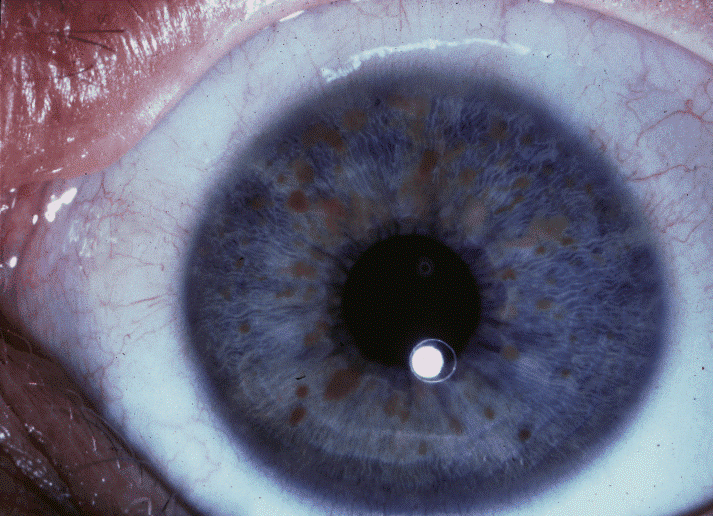
Lisch nodules
Encyclopedia

Hamartoma
A hamartoma is a benign, focal malformation that resembles a neoplasm in the tissue of its origin. This is not a malignant tumor, and it grows at the same rate as the surrounding tissues. It is composed of tissue elements normally found at that site, but which are growing in a disorganized mass...
tous nodular aggregate of dendritic melanocyte
Melanocyte
-External links: - "Eye: fovea, RPE" - "Integument: pigmented skin"...
s affecting the iris
Iris (anatomy)
The iris is a thin, circular structure in the eye, responsible for controlling the diameter and size of the pupils and thus the amount of light reaching the retina. "Eye color" is the color of the iris, which can be green, blue, or brown. In some cases it can be hazel , grey, violet, or even pink...
, named after Austrian ophthalmologist
Ophthalmology
Ophthalmology is the branch of medicine that deals with the anatomy, physiology and diseases of the eye. An ophthalmologist is a specialist in medical and surgical eye problems...
Karl Lisch
Karl Lisch
Karl Lisch was an Austrian ophthalmologist remembered for describing Lisch nodules.- Biography :...
(1907–1999), who first recognized them in 1937.
These nodule
Nodule (medicine)
For use of the term nodule in dermatology, see Nodule In medicine, a nodule refers to a relatively hard, roughly spherical abnormal structure....
s are found in neurofibromatosis type 1, and are present in greater than 94% of patients over the age of six. They are clear, yellow-brown, oval to round, dome-shaped papules that project from the surface of the iris. These nodules typically do not affect vision, but are very useful in diagnosis. They are detected by slit lamp
Slit lamp
The slit lamp is an instrument consisting of a high-intensity light source that can be focused to shine a thin sheet of light into the eye. It is used in conjunction with a biomicroscope...
examination. Immunohistochemistry
Immunohistochemistry
Immunohistochemistry or IHC refers to the process of detecting antigens in cells of a tissue section by exploiting the principle of antibodies binding specifically to antigens in biological tissues. IHC takes its name from the roots "immuno," in reference to antibodies used in the procedure, and...
stains positive against vimentin
Vimentin
Vimentin is a type III intermediate filament protein that is expressed in mesenchymal cells. IF proteins are found in all metazoan cells as well as bacteria. IF, along with tubulin-based microtubules and actin-based microfilaments, comprise the cytoskeleton...
and S-100
S-100 protein
S-100 protein is a family of low molecular weight protein found in vertebrates characterized by two calcium binding sites of the helix-loop-helix conformation. There are at least 21 different types of S100 proteins...
, and points to an ectoderm
Ectoderm
The "ectoderm" is one of the three primary germ cell layers in the very early embryo. The other two layers are the mesoderm and endoderm , with the ectoderm as the most exterior layer...
al origin. Their precise origin and structure, however, is still under debate. They are not found in neurofibromatosis type 2.

